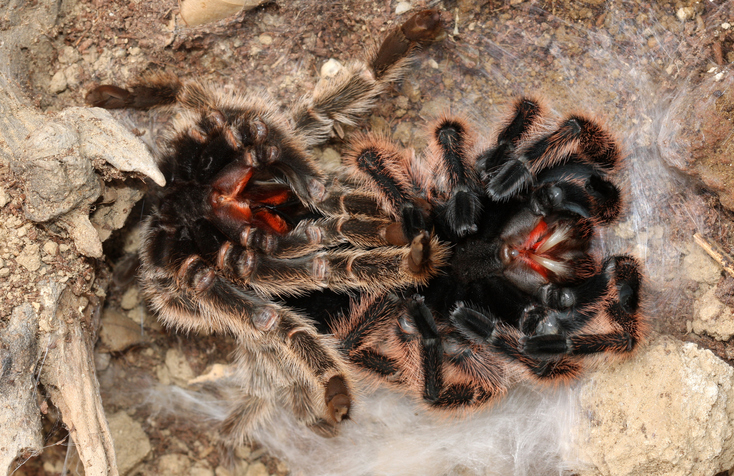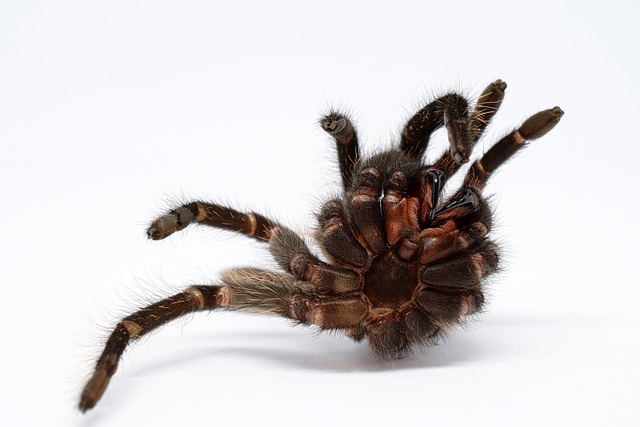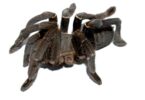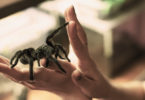Introduction
Ever noticed your pet tarantula acting a bit off? It’s likely gearing up for one heck of an outfit change – molting. This guide will unravel the mystery behind those exoskeleton escapes and teach you to be the best backstage crew during their big shed show.
Ready to peek inside nature’s dressing room? Let’s dive in!
Understanding Tarantula Molting
Peek into the world of these eight-legged wonders as they go through their ultimate wardrobe change — it’s molting season in Tarantulaville, folks! Now, imagine helping your little arachnid buddy out of its too-tight jeans; that’s pretty much what’s happening here, but on an epic, exoskeleton level.

Chilean Rose Hair Tarantula (Grammostola rosea) working its way out of its old skin (Molting).
What is Molting?
Molting is like a tarantula’s makeover. It’s when they get rid of their old exoskeleton—the hard, outer part of their body—and grow a new one. You see, as these cool critters grow bigger, that tough skin doesn’t stretch.
So they shed it and start fresh with a roomier one! Hormones inside the spider tell its body it’s time to start this big change.
It’s not just about getting bigger; molting is also about healing. If your eight-legged friend has any nicks, scratches or even broken leg, the new exoskeleton comes out all shiny and perfect—like brand-new armor after a battle! Imagine getting all-new skin whenever you scrape your knee—that’s what tarantulas do with molting.
It’s super important for their growth and keeping them healthy as they march along in their spider lives.
Frequency of Molting
Now that we’ve talked about what molting is, let’s dig into how often it happens. Young tarantulas can shed their exoskeleton quite a bit. They’re growing fast, so they might molt several times in one year.
It’s all part of their life cycle as they move from one instar to the next. But hold on – once tarantulas hit maturity, things slow down. Mature tarantulas will only molt about once each year.
This slowdown is just the way nature works for these amazing creatures.
Each time they get rid of an old exoskeleton, it’s like hitting a restart button on their growth and development. Think of molting as your eight-legged friend getting a brand-new suit because the old one doesn’t fit anymore! And with each new “suit,” they’re stepping closer to becoming big and strong adult tarantulas.
Cool, right? Keep this in mind: how often your spider buddy molts tells you something about where they are in their life story.
Signs Your Tarantula is Preparing to Molt
Oh boy, if you’ve noticed your eight-legged buddy acting a bit off lately, chances are it’s not just being quirky—it might just be gearing up for the big wardrobe change! Let’s dive into those tell-tale signs that hint your tarantula is about to do the ultimate striptease and shimmy out of its old exoskeleton.
Loss of Appetite
Your tarantula might start eating less or even stop completely as it gets ready to molt. This is normal, so don’t worry if you see your spider buddy turning down meals it usually loves.
It’s like they know they need to make room for their new skin.
It’s important not to keep dropping crickets in there if they’re just going to ignore them. Uneaten food can add stress, and that’s the last thing a molting tarantula needs. Just imagine being stuck in a tight shirt while someone keeps offering you sandwiches—you’d want some space too! So give them peace and leave your tarantula alone until they’ve finished molting.
They’ll get their appetite back soon after and be ready for more munchies!
Fat and Shiny Abdomen
Have you seen your tarantula sporting a belly that’s looking plumper and glossier than usual? Heads up, because this is a big clue they’re gearing up for a wardrobe change – molting! The abdominal swelling isn’t just for show; it means growth hormones are kicking into high gear.
This shiny, stretchy tummy can balloon to about 1.5 times its normal size, making your eight-legged friend look like it’s had way too much to eat.
Sometimes these chunky crawlers even lose some fuzz on their rumps. A light-colored bald spot might pop up where once there were hairs. It’s kind of like your spider’s saying, “Get ready, ’cause I’m about to slip out of this old skin and wow you with a brand-new one!” Keep an eye on that large abdomen; it’s not just fat — it’s the tarantula’s exoskeleton loosening up and preparing to shed off in style.
Changes in Color
Your tarantula’s colors tell a story, and it’s not just about looking fabulous. Before molting time, their exoskeleton gets kind of drab—a greyish tinge might creep in. It’s like nature’s way of saying, “Hey buddy, you’re about to trade up!” This color change signals that the big shed is right around the corner.
It means they’re getting ready to ditch that old skin and step into something new and snazzy. Keep an eye out for these changes—they’re key clues your eight-legged friend is stepping into the next chapter of spider life!
Increased Lethargy
Slower and more lethargic behavior is a key indicator that a tarantula is in the premolt stage. You might see your spider buddy moving less or just chilling in one spot for longer than usual.
This isn’t them being lazy, though—no sir! It’s their body getting ready for the big change.
Look out if they’re refusing food or seem thinner, even when offered their favorite snacks. And pacing? That’s another telltale sign. If they start doing laps around their cage like there’s no tomorrow, guess what: molting time could be right around the corner! Keep an eye on these behaviors; they’re like secret messages saying “Get ready, something cool is about to happen!”.
Constructing a Web “Mat” in its Enclosure
After noticing your tarantula isn’t moving much, you might see it start to spin a lot of silk. This is not just any web; it’s a special “molt mat”. Think of it like a cozy blanket where the spider can change out of its old skin in peace.
Tarantulas are clever creatures. They know they need a safe spot for molting, so they make this silk mat on top of the ground in their home.
The molt mat looks like a hammock and acts as a comfy bed while your pet arachnid works hard shedding its exoskeleton. So if you peek into the enclosure and spot this thick web, get ready! Your eight-legged friend is about to start the amazing transformation process known as molting.
Keep an eye out—this unique premolt behavior is one of the clear signs that big changes are coming soon for your tarantula!
The Molting Process: Step by Step
Molting is like a tarantula’s way of outgrowing its old clothes. Imagine how tight shoes feel when your feet grow; it’s similar for these spiders.
- First off, the tarantula starts to pump fluid between its old exoskeleton and its body. It’s like blowing up a balloon inside another, making space.
- Then comes the waiting game. The spider lies still for hours; it might look sick, but it’s prepping for the big event.
- Slowly but surely, the tarantula flips onto its back. Seeing this can be startling – don’t freak out; it’s normal!
- With much effort, small cracks appear in the old exoskeleton around the legs and body. Think of it as unzipping a tight jacket.
- Gentle movements from our eight – legged friend help widen these cracks. It pushes and pulls – this part is all about patience.
- Out pops the tarantula from its old shell, revealing a pale and soft new exoskeleton underneath. It looks fragile now but give it time.
- The new skin starts to harden pretty quickly in the fresh air. Imagine wearing wet clothes that gradually get stiff as they dry – same idea.
- During this time, fluids rush into the tarantula’s limbs. They stretch out to their full length, just like someone waking up from a nap with a big stretch.
Caring for Your Tarantula During and After Molting
Ever found yourself tiptoeing around your pet tarantula’s home, whispering sweet nothings to keep the peace during molting? (Spoiler alert: they’re deaf.) Molting is a truly exhausting day for your eight-legged buddy! And let me tell you, it’s a delicate time when our little arachnid friends deserve all the TLC we can give.
So grab that spray bottle and crank up the humidifier; it’s about to get tropical in here as we dive into pampering 101 for your transforming tarantula.
Providing a Stress-Free Environment
Your tarantula needs a chill place to hang out while it gets ready to molt. Just like us, they can feel the heat when things get too busy around them. So, keep it quiet near their home and try not to move them or their cage around too much.
Bright lights? Nope, they’re not a fan of those either during molting time.
It’s kinda like when we need some alone time – your eight-legged buddy feels the same way. Make sure the room is calm with no loud sounds that might scare them. Trust me; they’ll be super grateful for this ‘me time’ you give them! Keeping your own nerves in check helps too because if you’re cool as a cucumber, chances are your spider pal will stay calm as well.
Post-Molting Feeding Tips
After your tarantula has molted, give it some space. These little critters need time to get strong again before eating. It’s like after you take a big test—you just want to chill for a bit, right? Your spider buddy feels the same! They’ve had a hard workout shedding their old skin, so wait about a week or two before offering food.
This waiting lets their body firm up and be ready to munch.
Now, even if your eight-legged pal seems hungry, start slow. Think of it as serving them breakfast in bed after they’ve been sick. Fresh water is super important too; always keep that water dish full! Their bodies are thirsty from all that work.
Next up—be on the lookout for any molting problems your pet might face..
Common Molting Problems and Solutions
Sometimes, tarantulas can have trouble when they try to molt. They might get stuck in their old skin. This could hurt them and make it hard for them to move or eat. To help, make sure their home is not too dry.
The right wetness will let the skin slide off easier.
If a tarantula does not eat after molting, don’t worry at first. It’s normal for them to take time before they’re hungry again. But if many days pass and they still don’t want food, check if something else might be wrong like sickness or stress from being too cold or hot.
Keep their home just right and give them peace so they can heal up from their big change.
Conclusion
So, you’ve learned a ton about tarantula molting—pretty cool, huh? Remember these tips and watch your fuzzy friend with care. They’ll need some TLC during their big change. And hey, once they’re all done, you’ve got yourself a nearly brand-new spider pal! Keep those good vibes going and enjoy the awesome world of tarantulas.
FAQs
1. Do tarantulas eat their molt?
Tarantulas do not eat their molt, but a common phenomenon is consuming the remaining contents from the abdomen’s exuvia.
2. What happens if you touch a tarantula while its molting?
3. What should I do if my tarantula hasn’t moved in a long time while molting?
Just wait it out – sometimes they take ages to finish up their molt.
4. How often do tarantulas go through this molting thing?
Well, young ones molt more than older ones – could be lots or just once a year.
5. Can a tarantula eat right after it finishes molting?
Give them a break for about a week after molting; then they’ll be ready to munch again!







